Upper New York Bay
This article needs additional citations for verification. (January 2010) |


Upper New York Bay, sometimes called Upper Bay, is the traditonal inner harbor of the Port of New York and New Jersey, connected to the Lower Bay by The Narrows. It is enclosed by the New York City boroughs of Manhattan, Brooklyn, Staten Island and the Hudson County, New Jersey municipalities of Jersey City and Bayonne.
[1]
It is fed by the waters of the Hudson River (historically called the North River as it passes Manhattan), as well as the Gowanus Canal. It is connected to Lower New York Bay by the Narrows, to Newark Bay by the Kill Van Kull, and to Long Island Sound by the East River, which despite the name, is actually a tidal strait. It provides the main passage for the waters of the Hudson River as it empties through the Narrows. The channel of the Hudson as it passes through the harbor is called the Anchorage Channel and is approximately 50 feet deep in the mid point of the harbour. [2]
It contains several islands including Governors Island, near the mouth of the East River, as well Ellis Island, Liberty Island, and Robbins Reef which are supported by a large underwater reef on the New Jersey side of the harbor. The reef was historically one of the largest oyster beds in the world and provided a staple for the diet of all classes of citizens of New York City until the end of the 19th century, when the beds succumbed to pollution.[3]
Historically it has played an extremely important role in the commerce of the New York metropolitan area. Entering the Upper Bay by a passenger ship provides for the first glimpse of the Statue of Liberty and became the hallmark image representing the immigrant experience during the late 19th and early 20th century.
Since the 1950s, container ship traffic has been primarily routed through the Kill Van Kull to Port Newark-Elizabeth Marine Terminal, where it is consolidated for easier automated transfer to land conveyance.[4] As a consequence, the waterfront industries of the Upper Bay experienced a decline leading to diverse plans for revitalization. Liberty State Park along its western shore opened in 1976. In recent years, it has become a popular site for recreation sailing and kayaking.
The harbor is traversed by the Staten Island Ferry, which runs between Whitehall Street at the southernmost tip of Manhattan near Battery Park (South Ferry) and St. George Ferry Terminal on Richmond Terrace in Staten Island near Richmond County Borough Hall and Richmond County Supreme Court. NY Waterway operates routes across the bay and through the narrows to locations near Sandy Hook.[5]
The Upper Bay supports a very diverse population of marine species, allowing for recreational fishing, most commonly for striped bass and bluefish.[6]
See also
- Brooklyn Cruise Terminal
- Port Jersey
- MOTBY
- Geography of New York Harbor
- Cross-Harbor Rail Tunnel
- Liberty State Park
- Red Hook (Brooklyn)
- Liberty Island
- Ellis Island
- Communipaw Terminal
- Castle Clinton
- Black Tom
- New York Harbor
Notes
- ^ Hudson County New Jersey Street Map. Hagstrom Map Company, Inc. 2008. ISBN 0-8809-7763-9.
- ^ [1] Anchorage Channel dredging project]
- ^
Kurlansky, Mark (2006). The Big Oyster. New York: Random House Trade paerpbacks. ISBN ISBN978-0-345-47639-5.
{{cite book}}: Check|isbn=value: invalid character (help); Cite has empty unknown parameter:|coauthors=(help) - ^ Rieff, Henry, "Intrepretations of New York-New Jersey Agreements 1834 and 1921" (PDF), Newark Law Review, 1 (2)
- ^ New York Harbor ferry routes:map and info
- ^ Hudson River Estuary Dept. of Environmental Conservation, NY State.

